HIM6114: Analyzing Workflow for Health IT Implementation
VerifiedAdded on 2023/06/10
|7
|1400
|347
Report
AI Summary
This report provides an analysis of workflow in health IT implementation, focusing on the importance of workflow analysis for successful EHR system deployment. It reviews four peer-reviewed articles discussing various aspects of health IT implementation, including tools and techniques for workflow analysis, challenges in computerizing workflows, limitations of current implementation processes, and factors influencing the effective implementation of health services research findings. The report compares these articles, highlighting their strengths and weaknesses, and concludes with recommendations for future research, suggesting the development of a virtual electronic health record database using client-server architecture and object-oriented technologies. This report emphasizes the potential of IT technologies to improve healthcare processes and integrate electronic health records effectively.
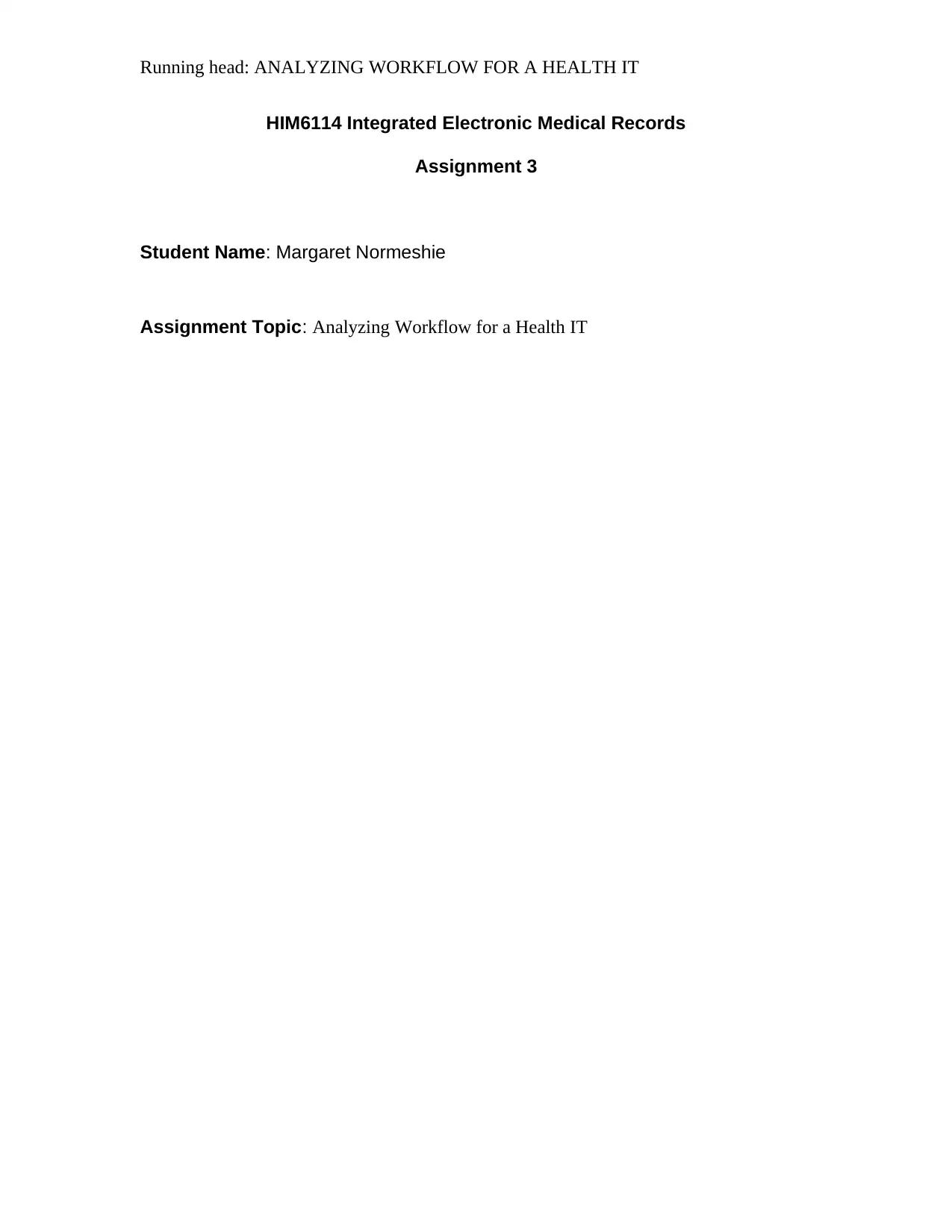
Running head: ANALYZING WORKFLOW FOR A HEALTH IT
HIM6114 Integrated Electronic Medical Records
Assignment 3
Student Name: Margaret Normeshie
Assignment Topic: Analyzing Workflow for a Health IT
HIM6114 Integrated Electronic Medical Records
Assignment 3
Student Name: Margaret Normeshie
Assignment Topic: Analyzing Workflow for a Health IT
Paraphrase This Document
Need a fresh take? Get an instant paraphrase of this document with our AI Paraphraser

1ANALYZING WORKFLOW FOR A HEALTH IT
Introduction
As the technology is developing rapidly, the application of the technology is also
affecting many private and government sectors. Health sectors are also affected highly by
this evolution. Health IT implementation has been adopted hugely to simplify the critical
and time-consuming processes such as integrating health records, workflow and many
more. The development of EHR systems into clinical workflow results a huge success to
integrate electronic health records. However, health sectors must analyze their workflow
process before implementing an EHR system. Four article associated with the health IT is
chosen and reviewed with proper comparison to offer a broad understanding of the
current development status and provide a future recommendation.
Review
Lydia Washington, the author of the “Analyzing Workflow for a Health IT
Implementation: an Often Short-shrifted Step is Essential in Successful IT Deployments”
widely discussed about the impact of workflow on EHR systems. This article provides
the basic understandings of some tools and technique to identify the environmental
factors for workflow analysis as well. It focuses on the workflow analysis and the
utilities associated with it. It also widely described the key process which are essential to
enable the optimal workflow (Meeks et al., 2014). According to Lydia, the data capture
by human-computer interface in health sectors provides many opportunities to improve
clinical and business process.
On the other hand, “Computerization of workflows, guidelines, and care
pathways: a review of implementation challenges for process-oriented health information
systems “is well written and organized by the Phil Gooch and Abdul Roudsari. They
Introduction
As the technology is developing rapidly, the application of the technology is also
affecting many private and government sectors. Health sectors are also affected highly by
this evolution. Health IT implementation has been adopted hugely to simplify the critical
and time-consuming processes such as integrating health records, workflow and many
more. The development of EHR systems into clinical workflow results a huge success to
integrate electronic health records. However, health sectors must analyze their workflow
process before implementing an EHR system. Four article associated with the health IT is
chosen and reviewed with proper comparison to offer a broad understanding of the
current development status and provide a future recommendation.
Review
Lydia Washington, the author of the “Analyzing Workflow for a Health IT
Implementation: an Often Short-shrifted Step is Essential in Successful IT Deployments”
widely discussed about the impact of workflow on EHR systems. This article provides
the basic understandings of some tools and technique to identify the environmental
factors for workflow analysis as well. It focuses on the workflow analysis and the
utilities associated with it. It also widely described the key process which are essential to
enable the optimal workflow (Meeks et al., 2014). According to Lydia, the data capture
by human-computer interface in health sectors provides many opportunities to improve
clinical and business process.
On the other hand, “Computerization of workflows, guidelines, and care
pathways: a review of implementation challenges for process-oriented health information
systems “is well written and organized by the Phil Gooch and Abdul Roudsari. They
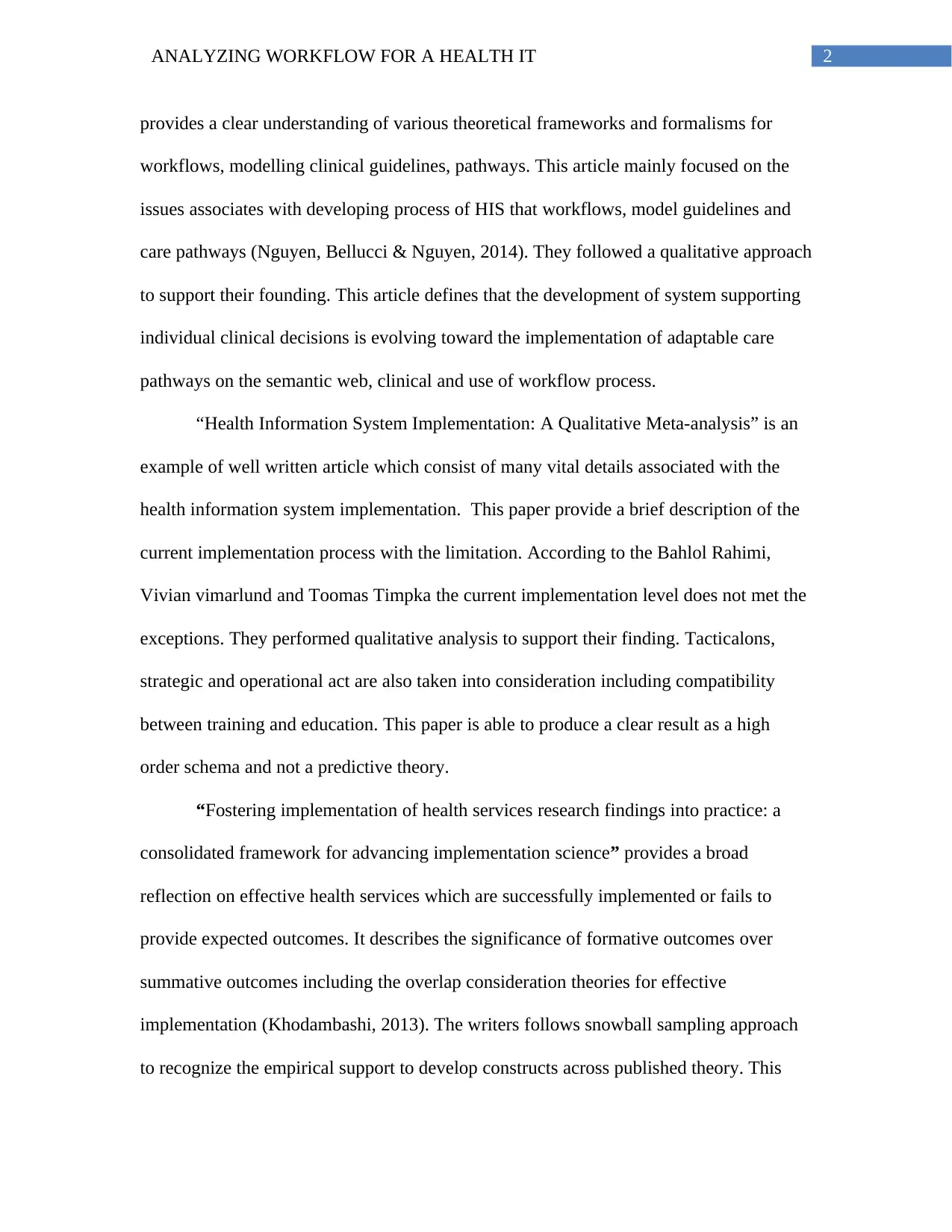
2ANALYZING WORKFLOW FOR A HEALTH IT
provides a clear understanding of various theoretical frameworks and formalisms for
workflows, modelling clinical guidelines, pathways. This article mainly focused on the
issues associates with developing process of HIS that workflows, model guidelines and
care pathways (Nguyen, Bellucci & Nguyen, 2014). They followed a qualitative approach
to support their founding. This article defines that the development of system supporting
individual clinical decisions is evolving toward the implementation of adaptable care
pathways on the semantic web, clinical and use of workflow process.
“Health Information System Implementation: A Qualitative Meta-analysis” is an
example of well written article which consist of many vital details associated with the
health information system implementation. This paper provide a brief description of the
current implementation process with the limitation. According to the Bahlol Rahimi,
Vivian vimarlund and Toomas Timpka the current implementation level does not met the
exceptions. They performed qualitative analysis to support their finding. Tacticalons,
strategic and operational act are also taken into consideration including compatibility
between training and education. This paper is able to produce a clear result as a high
order schema and not a predictive theory.
“Fostering implementation of health services research findings into practice: a
consolidated framework for advancing implementation science” provides a broad
reflection on effective health services which are successfully implemented or fails to
provide expected outcomes. It describes the significance of formative outcomes over
summative outcomes including the overlap consideration theories for effective
implementation (Khodambashi, 2013). The writers follows snowball sampling approach
to recognize the empirical support to develop constructs across published theory. This
provides a clear understanding of various theoretical frameworks and formalisms for
workflows, modelling clinical guidelines, pathways. This article mainly focused on the
issues associates with developing process of HIS that workflows, model guidelines and
care pathways (Nguyen, Bellucci & Nguyen, 2014). They followed a qualitative approach
to support their founding. This article defines that the development of system supporting
individual clinical decisions is evolving toward the implementation of adaptable care
pathways on the semantic web, clinical and use of workflow process.
“Health Information System Implementation: A Qualitative Meta-analysis” is an
example of well written article which consist of many vital details associated with the
health information system implementation. This paper provide a brief description of the
current implementation process with the limitation. According to the Bahlol Rahimi,
Vivian vimarlund and Toomas Timpka the current implementation level does not met the
exceptions. They performed qualitative analysis to support their finding. Tacticalons,
strategic and operational act are also taken into consideration including compatibility
between training and education. This paper is able to produce a clear result as a high
order schema and not a predictive theory.
“Fostering implementation of health services research findings into practice: a
consolidated framework for advancing implementation science” provides a broad
reflection on effective health services which are successfully implemented or fails to
provide expected outcomes. It describes the significance of formative outcomes over
summative outcomes including the overlap consideration theories for effective
implementation (Khodambashi, 2013). The writers follows snowball sampling approach
to recognize the empirical support to develop constructs across published theory. This
⊘ This is a preview!⊘
Do you want full access?
Subscribe today to unlock all pages.

Trusted by 1+ million students worldwide

3ANALYZING WORKFLOW FOR A HEALTH IT
article also demonstrate the five major domains of CFIR. This paper is a well written
article and all the theories are well described. However, they were failed to summarize
their founding and provides a poor conclusion.
Comparison:
The development of EHR systems into clinical workflow results a huge success to
integrate electronic health records. This four peer article is very moderate and well
written. Every paper provides different approaches and implementation process. The first
article provides a broad description of workflows associate with the tools and techniques
to identify the environmental factors (Rahimi, Vimarlund & Timpka, 2009). It also
focuses on the workflow analysis and the utilities associated with it. It also widely
described the key process which are essential to enable the optimal workflow (Hundt et
al., 2013). The second article widely describes about the HIS and processes associated
with it. This article is nicely organized however lacks in term of presentation. The
applications of the healthcare IT development was not clearly define. This paper provide
a brief description of the current implementation process with the limitation. According
to the Bahlol Rahimi, Vivian vimarlund and Toomas Timpka the current implementation
level does not met the exceptions. They performed qualitative analysis to support their
finding. Tacticalons, strategic and operational act are also taken into consideration
including compatibility between training and education. The four paper provides a broad
reflection on effective health services which are successfully implemented or fails to
provide expected outcomes.
article also demonstrate the five major domains of CFIR. This paper is a well written
article and all the theories are well described. However, they were failed to summarize
their founding and provides a poor conclusion.
Comparison:
The development of EHR systems into clinical workflow results a huge success to
integrate electronic health records. This four peer article is very moderate and well
written. Every paper provides different approaches and implementation process. The first
article provides a broad description of workflows associate with the tools and techniques
to identify the environmental factors (Rahimi, Vimarlund & Timpka, 2009). It also
focuses on the workflow analysis and the utilities associated with it. It also widely
described the key process which are essential to enable the optimal workflow (Hundt et
al., 2013). The second article widely describes about the HIS and processes associated
with it. This article is nicely organized however lacks in term of presentation. The
applications of the healthcare IT development was not clearly define. This paper provide
a brief description of the current implementation process with the limitation. According
to the Bahlol Rahimi, Vivian vimarlund and Toomas Timpka the current implementation
level does not met the exceptions. They performed qualitative analysis to support their
finding. Tacticalons, strategic and operational act are also taken into consideration
including compatibility between training and education. The four paper provides a broad
reflection on effective health services which are successfully implemented or fails to
provide expected outcomes.
Paraphrase This Document
Need a fresh take? Get an instant paraphrase of this document with our AI Paraphraser
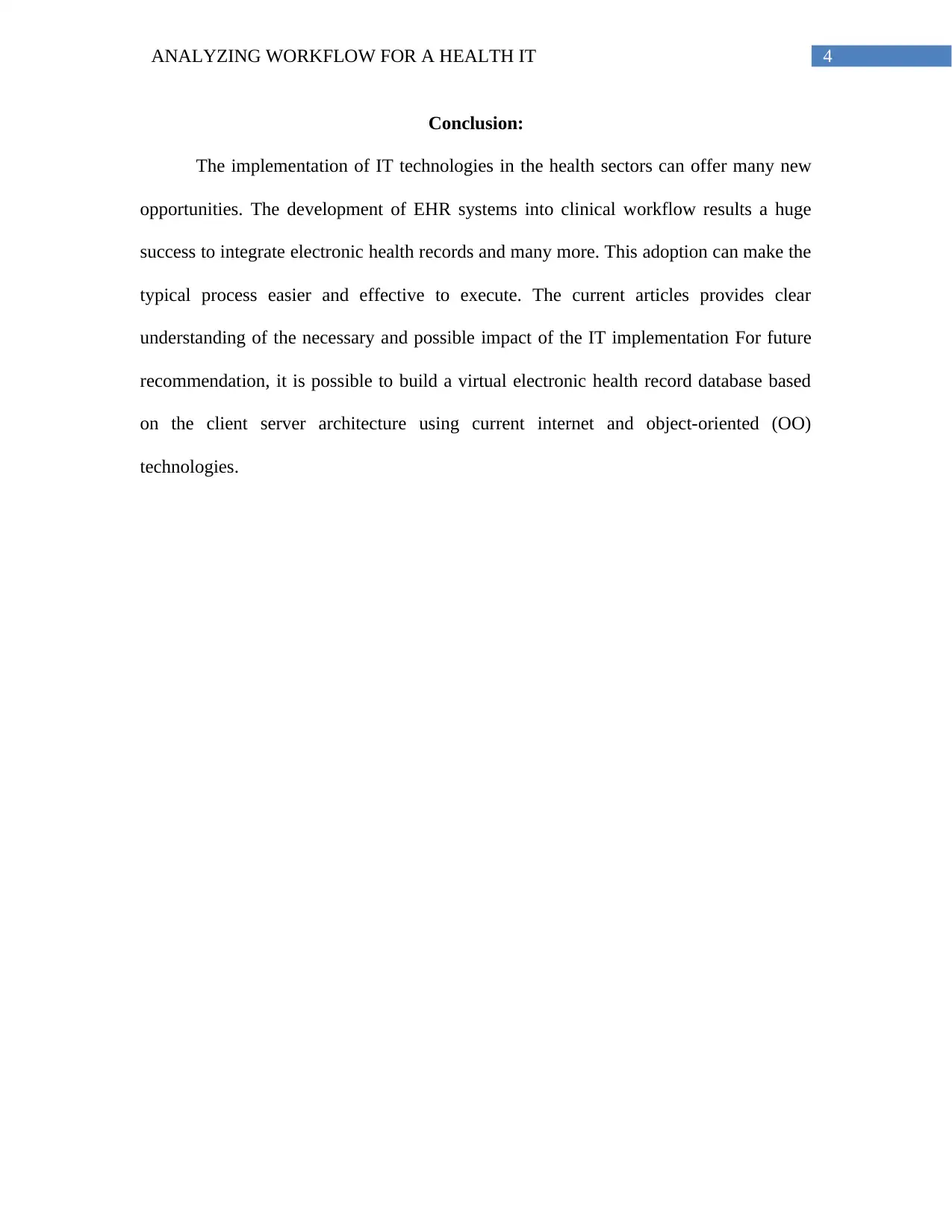
4ANALYZING WORKFLOW FOR A HEALTH IT
Conclusion:
The implementation of IT technologies in the health sectors can offer many new
opportunities. The development of EHR systems into clinical workflow results a huge
success to integrate electronic health records and many more. This adoption can make the
typical process easier and effective to execute. The current articles provides clear
understanding of the necessary and possible impact of the IT implementation For future
recommendation, it is possible to build a virtual electronic health record database based
on the client server architecture using current internet and object-oriented (OO)
technologies.
Conclusion:
The implementation of IT technologies in the health sectors can offer many new
opportunities. The development of EHR systems into clinical workflow results a huge
success to integrate electronic health records and many more. This adoption can make the
typical process easier and effective to execute. The current articles provides clear
understanding of the necessary and possible impact of the IT implementation For future
recommendation, it is possible to build a virtual electronic health record database based
on the client server architecture using current internet and object-oriented (OO)
technologies.
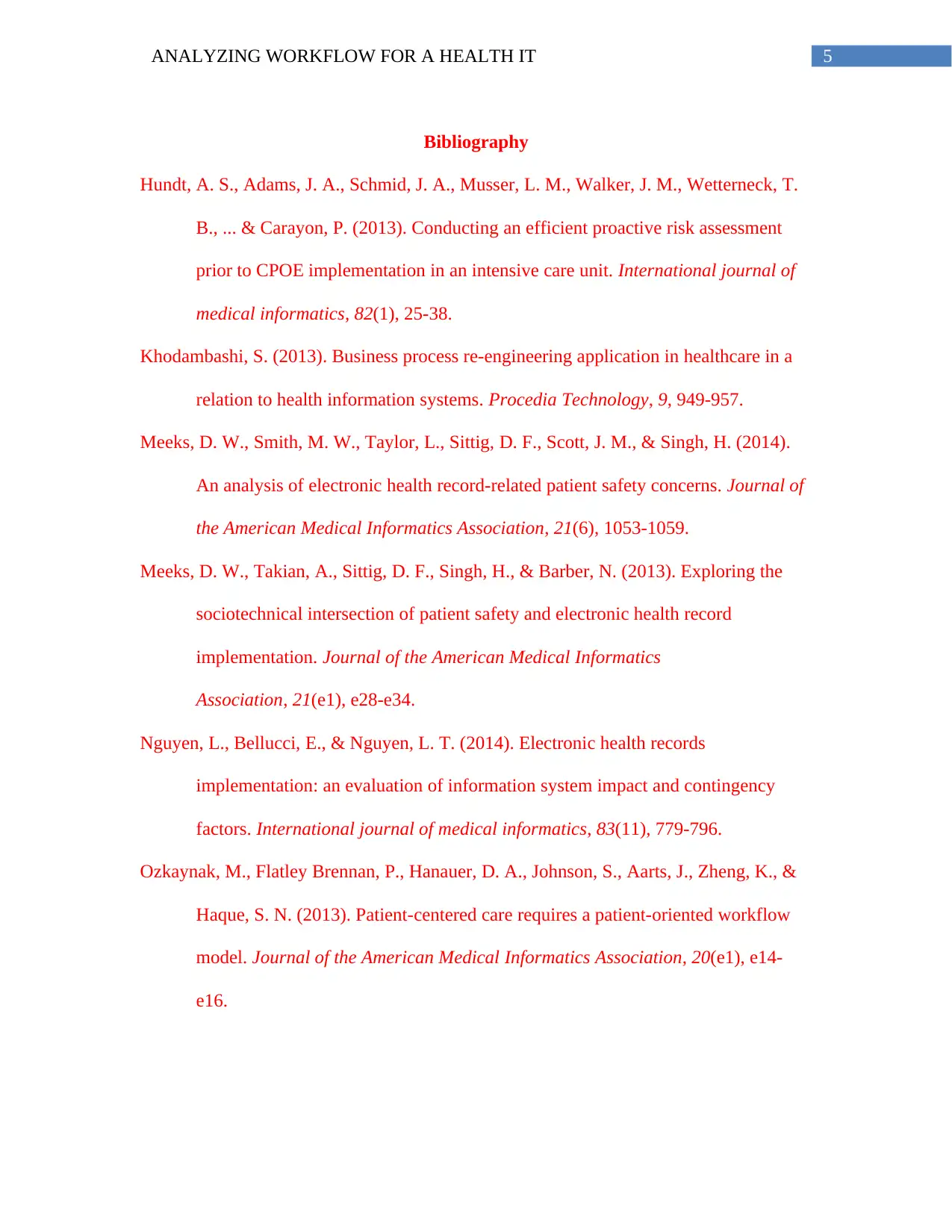
5ANALYZING WORKFLOW FOR A HEALTH IT
Bibliography
Hundt, A. S., Adams, J. A., Schmid, J. A., Musser, L. M., Walker, J. M., Wetterneck, T.
B., ... & Carayon, P. (2013). Conducting an efficient proactive risk assessment
prior to CPOE implementation in an intensive care unit. International journal of
medical informatics, 82(1), 25-38.
Khodambashi, S. (2013). Business process re-engineering application in healthcare in a
relation to health information systems. Procedia Technology, 9, 949-957.
Meeks, D. W., Smith, M. W., Taylor, L., Sittig, D. F., Scott, J. M., & Singh, H. (2014).
An analysis of electronic health record-related patient safety concerns. Journal of
the American Medical Informatics Association, 21(6), 1053-1059.
Meeks, D. W., Takian, A., Sittig, D. F., Singh, H., & Barber, N. (2013). Exploring the
sociotechnical intersection of patient safety and electronic health record
implementation. Journal of the American Medical Informatics
Association, 21(e1), e28-e34.
Nguyen, L., Bellucci, E., & Nguyen, L. T. (2014). Electronic health records
implementation: an evaluation of information system impact and contingency
factors. International journal of medical informatics, 83(11), 779-796.
Ozkaynak, M., Flatley Brennan, P., Hanauer, D. A., Johnson, S., Aarts, J., Zheng, K., &
Haque, S. N. (2013). Patient-centered care requires a patient-oriented workflow
model. Journal of the American Medical Informatics Association, 20(e1), e14-
e16.
Bibliography
Hundt, A. S., Adams, J. A., Schmid, J. A., Musser, L. M., Walker, J. M., Wetterneck, T.
B., ... & Carayon, P. (2013). Conducting an efficient proactive risk assessment
prior to CPOE implementation in an intensive care unit. International journal of
medical informatics, 82(1), 25-38.
Khodambashi, S. (2013). Business process re-engineering application in healthcare in a
relation to health information systems. Procedia Technology, 9, 949-957.
Meeks, D. W., Smith, M. W., Taylor, L., Sittig, D. F., Scott, J. M., & Singh, H. (2014).
An analysis of electronic health record-related patient safety concerns. Journal of
the American Medical Informatics Association, 21(6), 1053-1059.
Meeks, D. W., Takian, A., Sittig, D. F., Singh, H., & Barber, N. (2013). Exploring the
sociotechnical intersection of patient safety and electronic health record
implementation. Journal of the American Medical Informatics
Association, 21(e1), e28-e34.
Nguyen, L., Bellucci, E., & Nguyen, L. T. (2014). Electronic health records
implementation: an evaluation of information system impact and contingency
factors. International journal of medical informatics, 83(11), 779-796.
Ozkaynak, M., Flatley Brennan, P., Hanauer, D. A., Johnson, S., Aarts, J., Zheng, K., &
Haque, S. N. (2013). Patient-centered care requires a patient-oriented workflow
model. Journal of the American Medical Informatics Association, 20(e1), e14-
e16.
⊘ This is a preview!⊘
Do you want full access?
Subscribe today to unlock all pages.

Trusted by 1+ million students worldwide
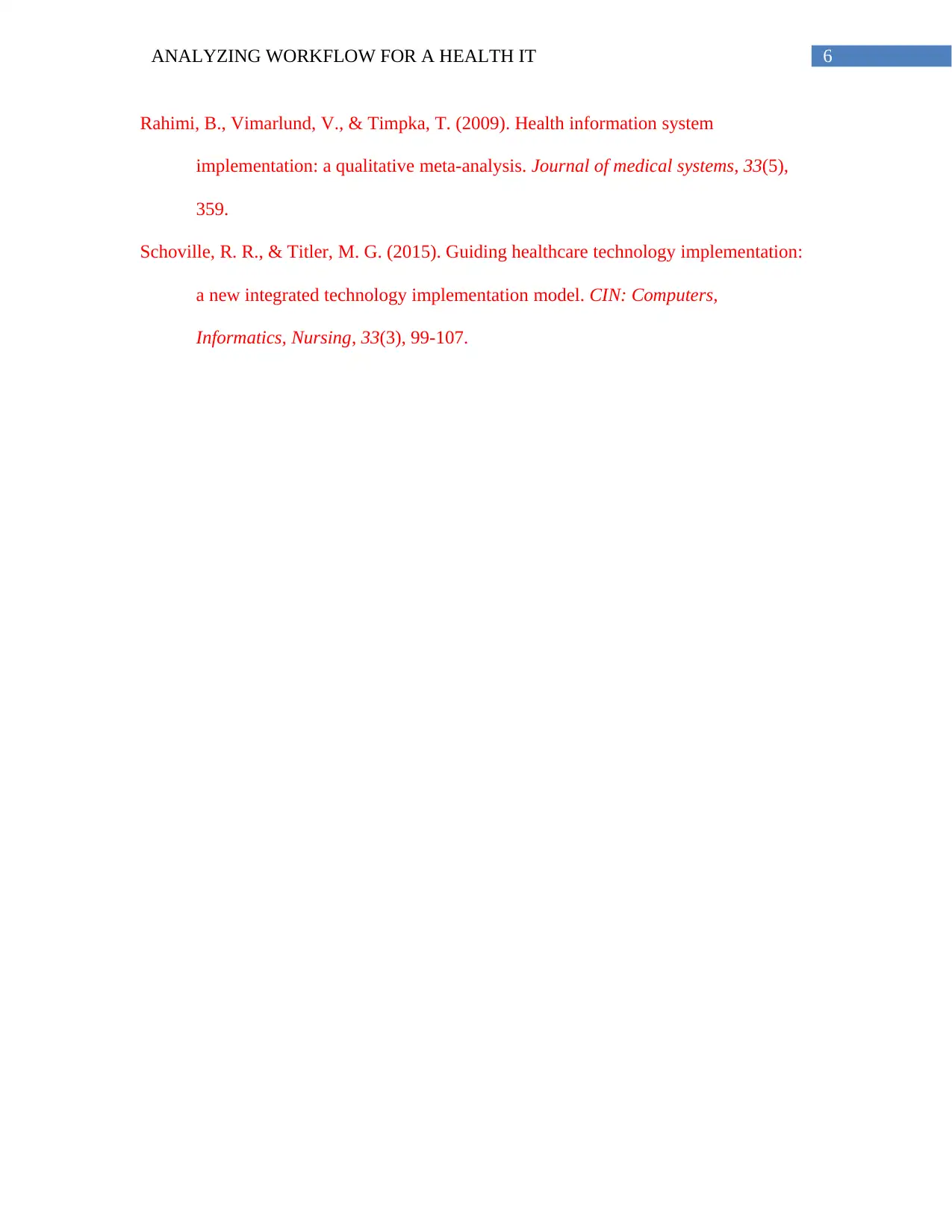
6ANALYZING WORKFLOW FOR A HEALTH IT
Rahimi, B., Vimarlund, V., & Timpka, T. (2009). Health information system
implementation: a qualitative meta-analysis. Journal of medical systems, 33(5),
359.
Schoville, R. R., & Titler, M. G. (2015). Guiding healthcare technology implementation:
a new integrated technology implementation model. CIN: Computers,
Informatics, Nursing, 33(3), 99-107.
Rahimi, B., Vimarlund, V., & Timpka, T. (2009). Health information system
implementation: a qualitative meta-analysis. Journal of medical systems, 33(5),
359.
Schoville, R. R., & Titler, M. G. (2015). Guiding healthcare technology implementation:
a new integrated technology implementation model. CIN: Computers,
Informatics, Nursing, 33(3), 99-107.
1 out of 7
Related Documents
Your All-in-One AI-Powered Toolkit for Academic Success.
+13062052269
info@desklib.com
Available 24*7 on WhatsApp / Email
![[object Object]](/_next/static/media/star-bottom.7253800d.svg)
Unlock your academic potential
Copyright © 2020–2025 A2Z Services. All Rights Reserved. Developed and managed by ZUCOL.





